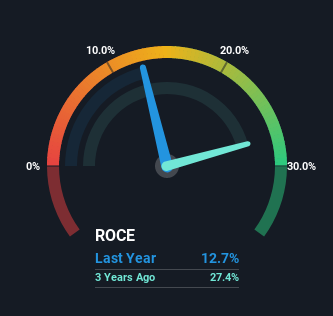Diwang Industrial Holdings (HKG:1950) Will Be Hoping To Turn Its Returns On Capital Around

There are a few key trends to look for if we want to identify the next multi-bagger. Typically, we'll want to notice a trend of growing return on capital employed (ROCE) and alongside that, an expanding base of capital employed. If you see this, it typically means it's a company with a great business model and plenty of profitable reinvestment opportunities. However, after investigating Diwang Industrial Holdings (HKG:1950), we don't think it's current trends fit the mold of a multi-bagger.
Return On Capital Employed (ROCE): What Is It?
Just to clarify if you're unsure, ROCE is a metric for evaluating how much pre-tax income (in percentage terms) a company earns on the capital invested in its business. The formula for this calculation on Diwang Industrial Holdings is:
Return on Capital Employed = Earnings Before Interest and Tax (EBIT) ÷ (Total Assets - Current Liabilities)
0.13 = CN¥36m ÷ (CN¥347m - CN¥67m) (Based on the trailing twelve months to June 2022).
Therefore, Diwang Industrial Holdings has an ROCE of 13%. In absolute terms, that's a pretty normal return, and it's somewhat close to the Chemicals industry average of 15%.
Check out our latest analysis for Diwang Industrial Holdings

While the past is not representative of the future, it can be helpful to know how a company has performed historically, which is why we have this chart above. If you'd like to look at how Diwang Industrial Holdings has performed in the past in other metrics, you can view this free graph of past earnings, revenue and cash flow.
So How Is Diwang Industrial Holdings' ROCE Trending?
In terms of Diwang Industrial Holdings' historical ROCE movements, the trend isn't fantastic. Over the last five years, returns on capital have decreased to 13% from 20% five years ago. However, given capital employed and revenue have both increased it appears that the business is currently pursuing growth, at the consequence of short term returns. If these investments prove successful, this can bode very well for long term stock performance.
On a related note, Diwang Industrial Holdings has decreased its current liabilities to 19% of total assets. So we could link some of this to the decrease in ROCE. What's more, this can reduce some aspects of risk to the business because now the company's suppliers or short-term creditors are funding less of its operations. Some would claim this reduces the business' efficiency at generating ROCE since it is now funding more of the operations with its own money.
The Key Takeaway
Even though returns on capital have fallen in the short term, we find it promising that revenue and capital employed have both increased for Diwang Industrial Holdings. Furthermore the stock has climbed 59% over the last year, it would appear that investors are upbeat about the future. So while the underlying trends could already be accounted for by investors, we still think this stock is worth looking into further.
If you want to know some of the risks facing Diwang Industrial Holdings we've found 4 warning signs (1 doesn't sit too well with us!) that you should be aware of before investing here.
While Diwang Industrial Holdings isn't earning the highest return, check out this free list of companies that are earning high returns on equity with solid balance sheets.
New: Manage All Your Stock Portfolios in One Place
We've created the ultimate portfolio companion for stock investors, and it's free.
• Connect an unlimited number of Portfolios and see your total in one currency
• Be alerted to new Warning Signs or Risks via email or mobile
• Track the Fair Value of your stocks
Have feedback on this article? Concerned about the content? Get in touch with us directly. Alternatively, email editorial-team (at) simplywallst.com.
This article by Simply Wall St is general in nature. We provide commentary based on historical data and analyst forecasts only using an unbiased methodology and our articles are not intended to be financial advice. It does not constitute a recommendation to buy or sell any stock, and does not take account of your objectives, or your financial situation. We aim to bring you long-term focused analysis driven by fundamental data. Note that our analysis may not factor in the latest price-sensitive company announcements or qualitative material. Simply Wall St has no position in any stocks mentioned.
About SEHK:1950
Diwang Industrial Holdings
An investment holding company, engages in the research and development, manufacture, and sale of coating agents and synthetic resins in the People’s Republic of China, Mexico, Turkey, and Vietnam.
Flawless balance sheet with solid track record.
Market Insights
Community Narratives



